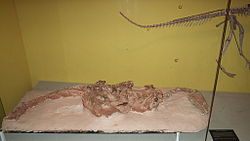瓜巴龍屬:修订间差异
內容擴充 |
內容擴充 |
||
| 第27行: | 第27行: | ||
[[正模標本]](編號'''MCN PV2355''')是一個保存良好的部分身體骨骼。[[副模標本]](編號'''MCN PV2356''')則是一個接近完整的左後肢,關節仍呈連接狀態。這兩個化石都發現於巴西南里約格蘭德州,位於著名的Paleorrota地質公園內,都是在名為「Prό-Guaíba Project」的挖掘化石計畫而發現。在瓜巴龍被命名後,近年在Paleorrota地質公園的另一個挖掘地點,發現另外兩個標本。編號'''UFRGS PV0725T'''標本是一個身體骨骼,缺少頸部、一個前肢、兩個腳掌。編號'''MCN PV 10112'''標本仍位在石塊中,還沒有經過去除石塊的手續<ref name=G-reassessment/>。這些化石都發現於Caturrita組地層的下部,地質年代相當於2億1650萬到2億1200萬年前,相當於三疊紀晚期的早[[諾利階]]<ref name=G-reassessment/><ref name=R-Nov>{{en}}{{cite journal |authors=Marina B. Soares, Cesar L. Schultz and Bruno L. D. Horn |year=2011 |title=New information on ''Riograndia guaibensis'' Bonaparte, Ferigolo & Ribeiro, 2001 (Eucynodontia, Tritheledontidae) from the Late Triassic of southern Brazil: anatomical and biostratigraphic implications |journal=Anais da Academia Brasileira de Ciências |volume=83 |issue=1 |pages=329–354 |url=http://www.scielo.br/pdf/aabc/v83n1/v83n1a21.pdf }}</ref>。 |
[[正模標本]](編號'''MCN PV2355''')是一個保存良好的部分身體骨骼。[[副模標本]](編號'''MCN PV2356''')則是一個接近完整的左後肢,關節仍呈連接狀態。這兩個化石都發現於巴西南里約格蘭德州,位於著名的Paleorrota地質公園內,都是在名為「Prό-Guaíba Project」的挖掘化石計畫而發現。在瓜巴龍被命名後,近年在Paleorrota地質公園的另一個挖掘地點,發現另外兩個標本。編號'''UFRGS PV0725T'''標本是一個身體骨骼,缺少頸部、一個前肢、兩個腳掌。編號'''MCN PV 10112'''標本仍位在石塊中,還沒有經過去除石塊的手續<ref name=G-reassessment/>。這些化石都發現於Caturrita組地層的下部,地質年代相當於2億1650萬到2億1200萬年前,相當於三疊紀晚期的早[[諾利階]]<ref name=G-reassessment/><ref name=R-Nov>{{en}}{{cite journal |authors=Marina B. Soares, Cesar L. Schultz and Bruno L. D. Horn |year=2011 |title=New information on ''Riograndia guaibensis'' Bonaparte, Ferigolo & Ribeiro, 2001 (Eucynodontia, Tritheledontidae) from the Late Triassic of southern Brazil: anatomical and biostratigraphic implications |journal=Anais da Academia Brasileira de Ciências |volume=83 |issue=1 |pages=329–354 |url=http://www.scielo.br/pdf/aabc/v83n1/v83n1a21.pdf }}</ref>。 |
||
近年新發現的編號'''UFRGS PV0725T'''標本,缺少大部分[[頸椎]],但根據僅存的基部頸椎,顯示這個個體在死亡前,頸部是朝向左方彎曲的。而根據化石的其他部位,後肢 |
近年新發現的編號'''UFRGS PV0725T'''標本,缺少大部分[[頸椎]],但根據僅存的基部頸椎,顯示這個個體在死亡前,頸部是朝向左方彎曲的。而根據化石的其他部位,後肢捲曲於身體下方,前肢擺向身體側方,這個姿勢很類似現代[[鳥類]]。在發現這個化石以前,只有[[手盜龍類]]化石層發現這種鳥類睡眠姿勢。研究人員推測,瓜巴龍可能採取這種姿勢睡眠,以保持體溫,如同現代鳥類<ref name=AM12>{{en}}{{cite journal |last=Agnolin |first=F. |coauthors=and Martinelli, A.G. |year=2012 |title=''Guaibasaurus candelariensis'' (Dinosauria, Saurischia) and the early origin of avian-like resting posture |journal=Alcheringa |volume=in press |doi=10.1080/03115518.2012.634203 |url=http://www.tandfonline.com/doi/abs/10.1080/03115518.2012.634203}}</ref>。 |
||
==詞源== |
==詞源== |
||
在1999年,[[阿根廷]]古生物學家[[約瑟·波拿巴]](José Bonaparte)等人將正模標本、副模標本敘述、命名。[[模式種]]是'''坎德拉里瓜巴龍'''(''Guaibasaurus candelariensis''),屬名裡的Guaíba,是南里約格蘭德州的地名,也是「Prό-Guaíba Project」挖掘計畫的名稱來源;種名則是以鄰近的Candelária市為名<ref name=Guaibasaurus>{{en}}{{cite journal |authors=José F. Bonaparte, Jorge Ferigolo and Ana Maria Ribeiro |year=1999 |title=A new early Late Triassic saurischian dinosaur from Rio Grande do Sol state, Brazil |journal=Proceedings of the Second Gondwanan Dinosaur Symposium, National Science Museum Monographs |volume=15 |issue= |pages=89–109 |url=http://ci.nii.ac.jp/els/110004312491.pdf?id=ART0006480804&type=pdf&lang=en&host=cinii&order_no=&ppv_type=0&lang_sw=&no=1321708519&cp= }}</ref>。 |
在1999年,[[阿根廷]]古生物學家[[約瑟·波拿巴]](José Bonaparte)等人將正模標本、副模標本敘述、命名。[[模式種]]是'''坎德拉里瓜巴龍'''(''Guaibasaurus candelariensis''),屬名裡的Guaíba,是南里約格蘭德州的地名,也是「Prό-Guaíba Project」挖掘計畫的名稱來源;種名則是以鄰近的Candelária市為名<ref name=Guaibasaurus>{{en}}{{cite journal |authors=José F. Bonaparte, Jorge Ferigolo and Ana Maria Ribeiro |year=1999 |title=A new early Late Triassic saurischian dinosaur from Rio Grande do Sol state, Brazil |journal=Proceedings of the Second Gondwanan Dinosaur Symposium, National Science Museum Monographs |volume=15 |issue= |pages=89–109 |url=http://ci.nii.ac.jp/els/110004312491.pdf?id=ART0006480804&type=pdf&lang=en&host=cinii&order_no=&ppv_type=0&lang_sw=&no=1321708519&cp= }}</ref>。 |
||
==演化與分類關係== |
|||
在1999年的命名研究裡,約瑟·波拿巴等人提出瓜巴龍是個原始[[獸腳類]]恐龍,並歸類於獨自的[[瓜巴龍科]]。在2007年,約瑟·波拿巴等人發現農神龍非常類似瓜巴龍,而農神龍也生存於相近時代的巴西。約瑟·波拿巴等人將瓜巴龍、農神龍都歸類於瓜巴龍科,並將瓜巴龍科改歸類為原始[[蜥腳形亞目]]恐龍,或者與蜥腳形亞目、獸腳亞目的最近共同祖先是近親。約瑟·波拿巴等人也提出,瓜巴龍、農神龍的外形比較類似獸腳類恐龍,而較不類似蜥腳形恐龍<ref name="bonaparteetal2007">{{enBonaparte, J.F., Brea, G., Schultz, C.L., and Martinelli, A.G. (2007). "A new specimen of ''Guaibasaurus candelariensis'' (basal Saurischia) from the Late Triassic Caturrita Formation of southern Brazil." ''Historical Biology'', '''19'''(1): 73-82.</ref>。發現新化石後,近年研究多傾向於瓜巴龍科是群非常原始的蜥腳形類恐龍<ref name=Y07>{{en}}{{cite journal| last1 = Yates | first1 = Adam M. | year = 2007 | title = The first complete skull of the Triassic dinosaur ''Melanorosaurus'' Haughton (Sauropodomorpha: Anchisauria) | journal = In Barrett & Batten (eds.), ''Evolution and Palaeobiology'' | volume = 77 | pages = 9–55 | ISBN = 9781405169332 }}</ref><ref name=poletal2011>{{en}}{{cite journal | author = Pol D., Garrido A., Cerda I.A. | year = 2011 | title = A New Sauropodomorph Dinosaur from the Early Jurassic of Patagonia and the Origin and Evolution of the Sauropod-type Sacrum | url = http://www.plosone.org/article/info:doi/10.1371/journal.pone.0014572 | journal = PLoS ONE | volume = 6 | issue = 1| page = e14572 | doi = 10.1371/journal.pone.0014572 | pmid=21298087 | pmc=3027623}}</ref><ref name=Leyesaurus>{{en}}{{cite journal |authors=Cecilia Apaldetti, Ricardo N. Martinez, Oscar A. Alcober and Diego Pol |year=2011 |title=A New Basal Sauropodomorph (Dinosauria: Saurischia) from Quebrada del Barro Formation (Marayes-El Carrizal Basin), Northwestern Argentina |url=http://www.plosone.org/article/info%3Adoi%2F10.1371%2Fjournal.pone.0026964 |journal=PLoS ONE |volume=6 |issue=11 |pages=e26964 |doi=10.1371/journal.pone.0026964 }}</ref>。但瓜巴龍本身的分類位置仍有爭議,有些研究認為是原始獸腳類恐龍<ref name=G-reassessment/>,其他研究則認為是原始蜥腳形恐龍<ref name="Ezcurra2010">{{en}}{{cite journal|author=Ezcurra, M. D.|year=2010 |title=A new early dinosaur (Saurischia: Sauropodomorpha) from the Late Triassic of Argentina: a reassessment of dinosaur origin and phylogeny|journal=Journal of Systematic Palaeontology|volume=8 |issue=3 |pages=371–425 |url=http://www.informaworld.com/smpp/content~db=all~content=a924950072~frm=titlelink}}</ref><ref name=Indiansaupo>{{en}}{{Cite journal|author=Fernando E. Novas, Martin D. Ezcurra, Sankar Chatterjee and T. S. Kutty |year=2011 |title=New dinosaur species from the Upper Triassic Upper Maleri and Lower Dharmaram formations of central India |journal=Earth and Environmental Science Transactions of the Royal Society of Edinburgh |volume=101 |issue=3-4 |pages=333–349 |doi=10.1017/S1755691011020093}}</ref>。 |
|||
==參考資料== |
==參考資料== |
||
2012年4月4日 (三) 22:44的版本
| 瓜巴龍 化石時期: | ||||||||||||||||
|---|---|---|---|---|---|---|---|---|---|---|---|---|---|---|---|---|
 編號ULBRA-PVT016標本,頭部、頸部是參考艾雷拉龍而重建
| ||||||||||||||||
| 保护状况 | ||||||||||||||||
|
化石
| ||||||||||||||||
| 科學分類 | ||||||||||||||||
| ||||||||||||||||
| 種 | ||||||||||||||||
|
瓜巴龍(學名:Guaibasaurus)是基礎蜥腳形亞目恐龍,生活於三疊紀晚期的南美洲。瓜巴龍的化石在發現於巴西南里約格蘭德州。如同艾雷拉龍,瓜巴龍的每隻手掌有三指及退化的兩指[1]。
模式種是坎德拉里瓜巴龍(G. candelariai),是由約瑟·波拿巴(Jose Bonaparte)及J. Ferigolo在1998年描述、命名。
發現
正模標本(編號MCN PV2355)是一個保存良好的部分身體骨骼。副模標本(編號MCN PV2356)則是一個接近完整的左後肢,關節仍呈連接狀態。這兩個化石都發現於巴西南里約格蘭德州,位於著名的Paleorrota地質公園內,都是在名為「Prό-Guaíba Project」的挖掘化石計畫而發現。在瓜巴龍被命名後,近年在Paleorrota地質公園的另一個挖掘地點,發現另外兩個標本。編號UFRGS PV0725T標本是一個身體骨骼,缺少頸部、一個前肢、兩個腳掌。編號MCN PV 10112標本仍位在石塊中,還沒有經過去除石塊的手續[1]。這些化石都發現於Caturrita組地層的下部,地質年代相當於2億1650萬到2億1200萬年前,相當於三疊紀晚期的早諾利階[1][2]。
近年新發現的編號UFRGS PV0725T標本,缺少大部分頸椎,但根據僅存的基部頸椎,顯示這個個體在死亡前,頸部是朝向左方彎曲的。而根據化石的其他部位,後肢捲曲於身體下方,前肢擺向身體側方,這個姿勢很類似現代鳥類。在發現這個化石以前,只有手盜龍類化石層發現這種鳥類睡眠姿勢。研究人員推測,瓜巴龍可能採取這種姿勢睡眠,以保持體溫,如同現代鳥類[3]。
詞源
在1999年,阿根廷古生物學家約瑟·波拿巴(José Bonaparte)等人將正模標本、副模標本敘述、命名。模式種是坎德拉里瓜巴龍(Guaibasaurus candelariensis),屬名裡的Guaíba,是南里約格蘭德州的地名,也是「Prό-Guaíba Project」挖掘計畫的名稱來源;種名則是以鄰近的Candelária市為名[4]。
演化與分類關係
在1999年的命名研究裡,約瑟·波拿巴等人提出瓜巴龍是個原始獸腳類恐龍,並歸類於獨自的瓜巴龍科。在2007年,約瑟·波拿巴等人發現農神龍非常類似瓜巴龍,而農神龍也生存於相近時代的巴西。約瑟·波拿巴等人將瓜巴龍、農神龍都歸類於瓜巴龍科,並將瓜巴龍科改歸類為原始蜥腳形亞目恐龍,或者與蜥腳形亞目、獸腳亞目的最近共同祖先是近親。約瑟·波拿巴等人也提出,瓜巴龍、農神龍的外形比較類似獸腳類恐龍,而較不類似蜥腳形恐龍[5]。發現新化石後,近年研究多傾向於瓜巴龍科是群非常原始的蜥腳形類恐龍[6][7][8]。但瓜巴龍本身的分類位置仍有爭議,有些研究認為是原始獸腳類恐龍[1],其他研究則認為是原始蜥腳形恐龍[9][10]。
參考資料
- ^ 1.0 1.1 1.2 1.3 (英文)Max C. Langer, Jonathas S. Bittencourt and Cesar L. Schultz. A reassessment of the basal dinosaur Guaibasaurus candelariensis, from the Late Triassic Caturrita Formation of south Brazil. Earth and Environmental Science Transactions of the Royal Society of Edinburgh. 2011, 101 (3-4): 301–332. doi:10.1017/S175569101102007X.
- ^ (英文)Marina B. Soares, Cesar L. Schultz and Bruno L. D. Horn. New information on Riograndia guaibensis Bonaparte, Ferigolo & Ribeiro, 2001 (Eucynodontia, Tritheledontidae) from the Late Triassic of southern Brazil: anatomical and biostratigraphic implications (PDF). Anais da Academia Brasileira de Ciências. 2011, 83 (1): 329–354.
- ^ (英文)Agnolin, F.; and Martinelli, A.G. Guaibasaurus candelariensis (Dinosauria, Saurischia) and the early origin of avian-like resting posture. Alcheringa. 2012,. in press. doi:10.1080/03115518.2012.634203.
- ^ (英文)José F. Bonaparte, Jorge Ferigolo and Ana Maria Ribeiro. A new early Late Triassic saurischian dinosaur from Rio Grande do Sol state, Brazil (PDF). Proceedings of the Second Gondwanan Dinosaur Symposium, National Science Museum Monographs. 1999, 15: 89–109.
- ^ {{enBonaparte, J.F., Brea, G., Schultz, C.L., and Martinelli, A.G. (2007). "A new specimen of Guaibasaurus candelariensis (basal Saurischia) from the Late Triassic Caturrita Formation of southern Brazil." Historical Biology, 19(1): 73-82.
- ^ (英文)Yates, Adam M. The first complete skull of the Triassic dinosaur Melanorosaurus Haughton (Sauropodomorpha: Anchisauria). In Barrett & Batten (eds.), Evolution and Palaeobiology. 2007, 77: 9–55. ISBN 9781405169332.
- ^ (英文)Pol D., Garrido A., Cerda I.A. A New Sauropodomorph Dinosaur from the Early Jurassic of Patagonia and the Origin and Evolution of the Sauropod-type Sacrum. PLoS ONE. 2011, 6 (1): e14572. PMC 3027623
 . PMID 21298087. doi:10.1371/journal.pone.0014572.
. PMID 21298087. doi:10.1371/journal.pone.0014572.
- ^ (英文)Cecilia Apaldetti, Ricardo N. Martinez, Oscar A. Alcober and Diego Pol. A New Basal Sauropodomorph (Dinosauria: Saurischia) from Quebrada del Barro Formation (Marayes-El Carrizal Basin), Northwestern Argentina. PLoS ONE. 2011, 6 (11): e26964. doi:10.1371/journal.pone.0026964.
- ^ (英文)Ezcurra, M. D. A new early dinosaur (Saurischia: Sauropodomorpha) from the Late Triassic of Argentina: a reassessment of dinosaur origin and phylogeny. Journal of Systematic Palaeontology. 2010, 8 (3): 371–425.
- ^ (英文)Fernando E. Novas, Martin D. Ezcurra, Sankar Chatterjee and T. S. Kutty. New dinosaur species from the Upper Triassic Upper Maleri and Lower Dharmaram formations of central India. Earth and Environmental Science Transactions of the Royal Society of Edinburgh. 2011, 101 (3-4): 333–349. doi:10.1017/S1755691011020093.
外部連結
- (中文)瓜巴龍
- (葡萄牙文)Dinosaurs of Rio grande do Sul.
